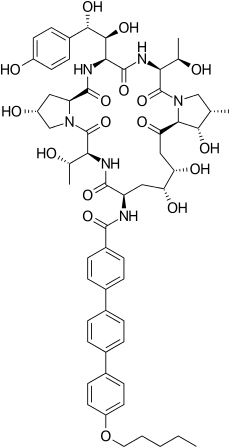Anidulafungin
 | |
| Systematic (IUPAC) name | |
|---|---|
| N-[(3S,6S,9S,11R,15S,18S,20R,21R,24S,25S,26S)-6-[(1S,2R)-1,2-dihydroxy-2-(4-hydroxyphenyl)ethyl]-11,20,21,25-tetrahydroxy-3,15-bis[(1R)-1-hydroxyethyl]-26-methyl-2,5,8,14,17,23-hexaoxo-1,4,7,13,16,22-hexaazatricyclo[22.3.0.09,13]heptacosan-18-yl]- 4-{4-[4-(pentyloxy)phenyl]phenyl}benzamide | |
| Clinical data | |
| Trade names | Eraxis |
| AHFS/Drugs.com | monograph |
| Pharmacokinetic data | |
| Protein binding | 84 % |
| Half-life | 40–50 hours |
| Identifiers | |
|
166663-25-8 | |
| J02AX06 | |
| PubChem | CID 166548 |
| DrugBank |
DB00362 |
| ChemSpider |
21106258 |
| UNII |
9HLM53094I |
| KEGG |
D03211 |
| ChEMBL |
CHEMBL1630215 |
| Chemical data | |
| Formula | C58H73N7O17 |
| 1140.24 g/mol | |
|
SMILES
| |
| |
| | |
Anidulafungin or Eraxis (Ecalta in Europe) is a semisynthetic echinocandin used as an antifungal drug. Anidulafungin was originally manufactured and submitted for FDA approval by Vicuron Pharmaceuticals.[1] Pfizer acquired the drug upon its acquisition of Vicuron in the fall of 2005.[2] Pfizer gained approval by the Food and Drug Administration (FDA) on February 21, 2006;[3] it was previously known as LY303366. Preliminary evidence indicates it has a similar safety profile to caspofungin. Anidulafungin has proven efficacy against esophageal candidiasis, but its main use will probably be in invasive Candida infection;[4][5][6] it may also have application in treating invasive Aspergillus infection. It is a member of the class of antifungal drugs known as the echinocandins; its mechanism of action is by inhibition of (1→3)-β-D-glucan synthase, an enzyme important to the synthesis of the fungal cell wall.
Pharmacodynamics and pharmacokinetics
Anidulafungin significantly differs from other antifungals in that it undergoes chemical degradation to inactive forms at body pH and temperature. Because it does not rely on enzymatic degradation or hepatic or renal excretion, the drug is safe to use in patients with any degree of hepatic or renal impairment.[7]
Distribution: 30–50 L. Protein binding: 84%.
Anidulafungin is evidently metabolized by the liver. This specific drug undergoes slow chemical hydrolysis to an open-ring peptide which lacks antifungal activity. The half-life of the drug is 27 hours. Thirty percent is excreted in the feces (10% as unchanged drug). Less than 1% is excreted in the urine.[8][9][10]
Mechanism of action
Anidulafungin inhibits glucan synthase, an enzyme important in the formation of (1→3)-β-D-glucan, a major fungal cell wall component. Glucan synthase is not present in mammalian cells, so it is an attractive target for antifungal activity.[11]
Semisynthesis
Anidulafungin is manufactured via semisynthesis. The starting material is echinocandin B (a lipopeptide fermentation product of Aspergillus nidulans or the closely related species, A. rugulosus), which undergoes deacylation (cleavage of the linoleoyl side chain) by the action of a deacylase enzyme from the bacterium Actinoplanes utahensis;[12] in three subsequent synthetic steps, including a chemical reacylation, the antifungal drug anidulafungin[13][11] is synthesized.
References
- ↑ PRNewswire. Vicuron Pharmaceuticals Files New Drug Application (NDA) for Anidulafungin for Treatment of Invasive Candidiasis/Candidemia 08-18-2005.
- ↑ PRNewswire. Vicuron Pharmaceuticals Stockholders Approve Merger With Pfizer 08-15-2005
- ↑ "FDA Approves New Treatment for Fungal Infections". FDA News Release. Food and Drug Administration. 2006-02-21. Archived from the original on 10 July 2009. Retrieved 2009-08-01.
- ↑ Krause DS, Reinhardt J, Vazquez JA, Reboli A, Goldstein BP, Wible M, Henkel T (2004). "Phase 2, randomized, dose-ranging study evaluating the safety and efficacy of anidulafungin in invasive candidiasis and candidemia". Antimicrob Agents Chemother 48 (6): 2021–4. doi:10.1128/AAC.48.6.2021-2024.2004. PMC 415613. PMID 15155194.
- ↑ Pfaller MA, Boyken L, Hollis RJ, Messer SA, Tendolkar S, Diekema DJ (2005). "In Vitro Activities of Anidulafungin against More than 2,500 Clinical Isolates of Candida spp., Including 315 Isolates Resistant to Fluconazole". J Clin Microbiol 43 (11): 5425–7. doi:10.1128/JCM.43.11.5425-5427.2005. PMC 1287823. PMID 16272464.
- ↑ Pfaller MA, Diekema DJ, Boyken L, Messer SA, Tendolkar S, Hollis RJ, Goldstein BP (2005). "Effectiveness of anidulafungin in eradicating Candida species in invasive candidiasis". Antimicrob Agents Chemother 49 (11): 4795–7. doi:10.1128/AAC.49.11.4795-4797.2005. PMC 1280139. PMID 16251335.
- ↑ "Eraxis at RxList". 2009-06-24. Retrieved 2009-08-01.
- ↑ Trissel LA and Ogundele AB, "Compatibility of Anidulafungin With Other Drugs During Simulated Y-Site Administration,"Am J Health-Sys Pharm, 2005, 62:834-7.
- ↑ Vazquez JA, "Anidulafungin: A New Echinocandin With a Novel Profile," Clin Ther, 2005, 27(6):657-73.
- ↑ Walsh TJ, Anaissie EJ, Denning DW, et al, "Treatment of Aspergillosis: Clinical Practice Guidelines of the Infectious Diseases Society of America," Clin Infect Dis, 2008, 46(3):327-60
- ↑ 11.0 11.1 Denning DW (1997). "Echinocandins and pneumocandins - a new antifungal class with a novel mode of action". J Antimicrob Chemother 40 (5): 611–614. doi:10.1093/jac/dkf045. PMID 9421307.
- ↑ Lei Shao, Jian Li, Aijuan Liu, Qing Chang, Huimin Lin, Daijie Chen (2013). "Efficient Bioconversion of Echinocandin B to Its Nucleus by Overexpression of Deacylase Genes in Different Host Strains". Applied and Environmental Microbiology 79 (4): 1126–1133. doi:10.1128/AEM.02792-12. PMC 3568618. PMID 23220968.
- ↑ "Anidulafungin EMA Europa".
| ||||||||||||||||||||||||||||||||||||||||||||||||||||||||||||||||||||